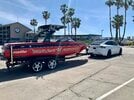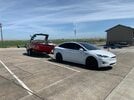There are a number of things that add to the towing capacity of your wheel/tire set. The biggest is the tire. Let me explain this first, then I'll get to the load capacity. Every car has the speedometer calibrated for a certain circumference wheel/tire setup. Circumference is defined a Pi * diameter. Since Pi is constant, then in the diameter of the wheel/tire setup must be kept constant to keep the speedometer reading correctly. So, let's say that the diameter of a Model X wheel/tire set is 27". With 19" wheels, the tire side wall is then 4" (19" + 4" top + 4" bottom). For a 22" wheel, the tire sidewall is just 2.5". How does this affect load rating (towing capacity)? Well, the sidewall of the tire is what provides the stability. It is like a spring. So, as the sidewall gets smaller, the load index of the tire generally gets less. Now, you can shop and buy tires with all sorts of load and speed ratings, but assume that the tires in my example have the same 'spring rating' of the side wall at say 5000 lbs/inch of compression. If you load the 4" sidewall tire with 5,000 lbs (car and add'l load), the sidewall will deflect approximately 1" or 1/4. However, if you loaded the 2.5" sidewall with the same load, it would deflect the same 1" but it would be 40% of the sidewall and most definitely blowout. I know this is a layman's example and that there are a lot more technical terms and formulas that I could have used, but for the basic answer of why does a larger wheel have a lower load rating, I hope this helps. Mike




